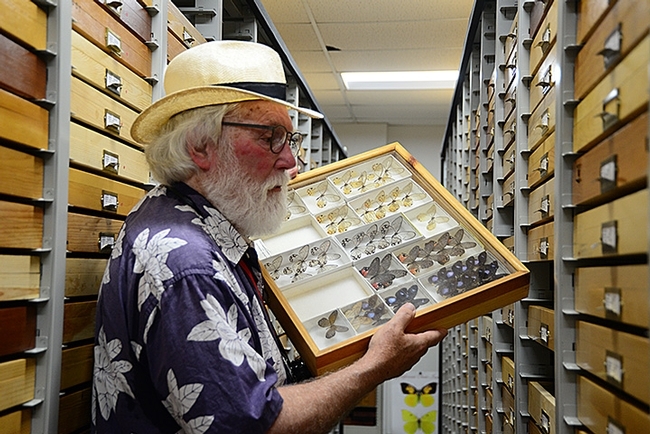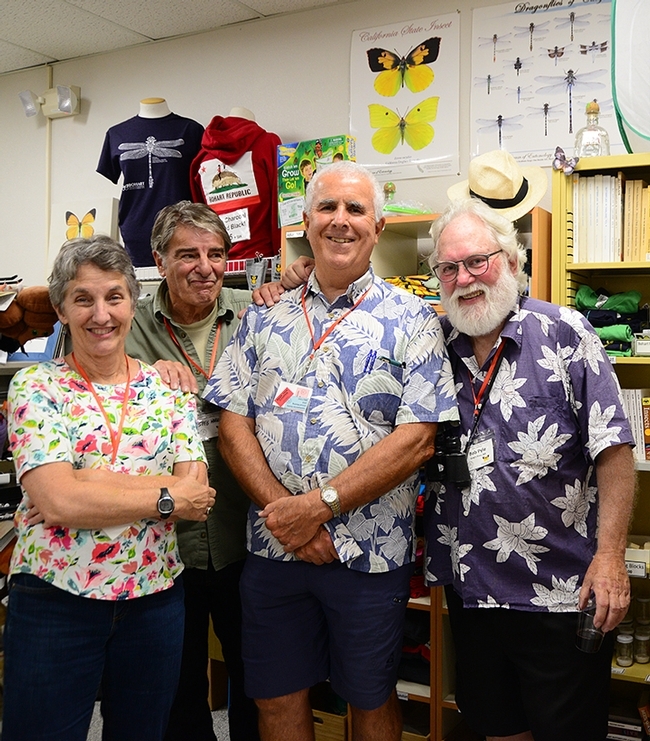UC Gardening Blogs
Robert Michael Pyle: The Face of Insect Conservation
Robert Michael Pyle, founder of the Xerces Society for Invertebrate Conservation, was right at...

Scholar, writer, biologist and educator Robert Michael Pyle visiting the UC Davis Bohart Museum of Entomology lepidoptera collection in July of 2019. (Photo by Kathy Keatley Garvey)

Bob Pyle locates Magdalene alpine butterfly specimens at the Bohart Museum of Entomology. (Photo by Kathy Keatley Garvey)

Robert Michael Pyle (far right) at the Bohart Museum of Entomology. From left are Lynn Kimsey, director of the Bohart Museum and UC Davis distinguished professor of entomology; Bohart associate Greg Kareofelas and entomologist Jeff Smith, curator of the lepidoptera collection. (Photo by Kathy Keatley Garvey)
How Plants Got their Names
Have you ever wondered how flowers got their names? I know I have. I have a book 100 Flowers and How They Got Their Names by Diana Wells. In the book, she tells of how 100 plants were named. I decided to look up two plants that I have in my yard. There are some flowers I have growing that she does not mention. Below are two I do have.
ROSES
The Rose family name is Rosaceae. It represents the love and the mystery of life. The name refers to its color in Latin rosa means red. The name is said to be dated back to early civilization. Hybrids and descendants of roses with the white rose X represent the House of York in the War of the Roses. Another interesting tidbit is the Persian word for rose is “gul” which means flower.
CAMELLIA
The Camellia family name Theaceae is the result of centuries of cultivation in China. The name reflects that it is a relative of the tea plant.
The story goes that it was named after “Lady of the Camillas” a famous 10th Century French Courtesan because she always carried a bouquet of camellias.
But Linnaeus named the flowers after George Josef Kamel. Linnaeus changed its “K” to a “C” as the Latin alphabet has no “K”.
This is just a small bit of information for each of these two plants. If you are interested and want to learn more, you can check your local library or go online to locate this book.

photo by Betty Victor
Kelli Hoover: Born in Texas, Raised in California, Schooled in Insects
Born in Lubbock, Texas, raised in the south San Francisco area, and schooled in insects. That was...

This UC Davis 1993 image shows doctoral students Kelli Hoover (foreground), Bryony Bonning and Bill McCutcheon with their major professor, Sean Duffey, 1943-1997. Duffey, vice chair of the Department of Entomology, died May 21, 1997 of an embolism from undiagnosed lung cancer.
Ticks
California lays claim to about 48 tick species, most that don't cause humans problems. However, one species is now creating a surge of Lyme Disease along the coastal areas. A tiny sesame-seed-sized insect, the Western black-legged tick is the culprit. For years the Center for Disease Control attributed Lyme cases in our state to returning travelers who contracted the disease while visiting the eastern US. Lyme disease antibody titers often take weeks to rise enough to be measurable in blood. Even then, Borrelia burgdorferi, the bacterial cause of Lyme Disease, doesn't stay in the bloodstream. It moves to the tissues. Typically, it can cause fever, achiness, swollen lymph nodes, and in about 70-80% of victims a bullseye rash. If not treated with the appropriate antibiotic, it can go on to cause facial palsy, swollen joints and arthritis, and even heart problems – Lyme carditis.
Ticks are not born with Lyme; they get the disease from their blood meal's host. For the eastern US, the usual host is the white-footed mouse. For the western US, the host is most often the gray squirrel. Over their two-year life cycle, they will need only 3 blood meals to survive. They are remarkably resistant to situations that would kill a human. They can survive a month submerged in water due to a dense, impervious cuticle and a very slow metabolic rate requiring hardly any oxygen. Years ago, I removed an engorged tick from my dog and put it in a small Rubbermaid container for two days in the refrigerator to take to the veterinarian (when they reopened) for identification. At the vet's office, the front staff took the lid off the container, dumped it over on the desk in front of us, and that tick actually did a little jump. Every one of us jumped back and gave a little scream. Two days at 34 degrees in an airless container was nothing to that tick. Since they were not doing tick ID at that time, they hit it hard with a hard object. End of tick.
While there are currently two potential human Lyme vaccines in the future in Europe, and one for dogs currently available in the US, the best advice from the CDC is the following:
Wear permethrin-coated clothing when in areas with ticks.
Wearing light-colored, full-body clothing will make it easier to see ticks. Tuck pant legs inside socks and shirts inside pants. One researcher uses duct tape wrapped sticky-side out around where his pants are tucked into his socks.
When hiking, choose the center of the trail to avoid brushing against vegetation.
Make sure to treat your pets with a tick prevention medication.
Check yourself, your kids, and your pets fully, after hiking, gardening, or brushing against any vegetation.
If you find a tick, use fine-tip tweezers at the skin level to pull it straight off slowly (no twisting) and then wash the area with an antiseptic. This is the only method that works. A lit match on the tick's bum will not get the tick to rear its head. Vaseline or gasoline will not asphyxiate it.
Shower within 24 hours. (Some authorities say 48 hours.) Wash your clothes immediately, too.
Current studies are looking at a fungus that is an environmentally safe tick biocide that can be sprayed on properties and also a bait box for the white-footed mice that contains a drop of Fipronil (the active ingredient in many tick preventatives for canines.) Parasitoid wasps are also being investigated. Other research is investigating how opossums are able to kill more than 90% of ticks that land on them.
Researchers collect ticks from woodlands and coastal scrub areas with tick drags: dragging a heavy white flannel cloth over the foliage and grasses 18 inches and below from the ground and counting how many ticks have latched onto the cloth. Ticks wait to latch onto hosts when something they are on is brushed against by a potential host. As gardeners, we can do this on our own properties. Acaricides can be sprayed on the property to kill ticks as well.
Lyme Disease is only one of fifteen diseases ticks transmit. Let's be vigilant!

screenshot from CDC on Twitter
What's in your pocket?
By Matt E.Navarro I'd be curious to know: what items do we carry with us into the garden? That is,...



